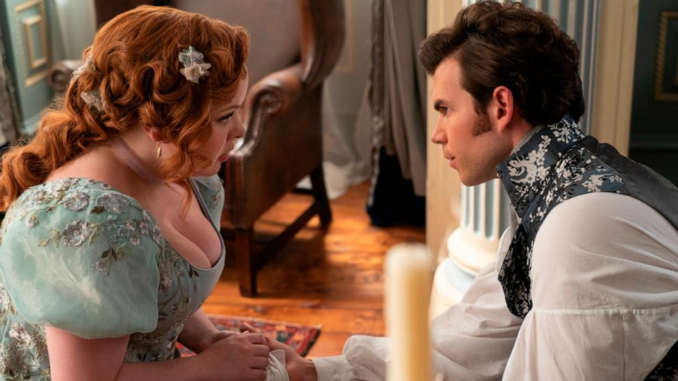
For those of us who enjoy a deliciously steamy period romance, this spring season has fed us well. First, Netflix released Bridgerton season 3 in two parts across May and June, and soon after, Prime Video dropped this month’s surprise hit, My Lady Jane.
Both are English period romances based on books, so naturally, much of the same audience attached to Bridgerton season 3 latched on to My Lady Jane. There’s no such thing as too much period romance, after all. And yet, though the similarities between the two shows basically stop there, entertainment outlets and fans on social media alike have taken to pitting the two series against one another. My question is simple: why?
What is there to compare?

In all honesty, there is very little reason to compare these two shows. Bridgerton takes place in Regency-era London. The town is ruled by money, social niceties, and gossip, and the Queen (Golda Rosheuvel) attends the balls of leading Lords and Ladies everywhere, gleefully meddling in their marriages and huffing snuff. The Ton has little time for the plights of those beneath their social standing, and the drama comes from the central romances, family feuds, and Lady Whistledown’s grip on society alone. It is a gorgeous, anachronistic, escapist narrative, filled with yearning, fleeting touches, and the ever-present potential for social ruin.
My Lady Jane, on the other hand, takes place in Tudor England. It’s an entirely different historical era—several centuries removed, in fact—the Royals play a much more central role within the country, everyone is scheming to get closer to power, and women arguably had even fewer rights than they did in the Regency era. The sociopolitical divide between the rich and the poor, and, in My Lady Jane’s case, the Ethians (shape-shifters) and the Verity (non-shape-shifters) drive the story forward. Lady Jane Grey’s (Emily Bader) and Lord Guildford Dudley’s (Edward Bluemel) arranged marriage and subsequent romance is a central part of the plot, but it is deeply intertwined with the Royal Family’s drama and the imminent threat of civil war. How is that in any way comparable to what happens in Bridgerton?
If My Lady Jane absolutely needs to be compared to anything in the Bridgerton “universe,” it should surely be Queen Charlotte: A Bridgerton Story. At least then, both shows feature loving and complicated arranged marriages that have an impact on the Royal Family and society as a whole. But I digress.
Bridgerton and My Lady Jane may both be period romances, but Bridgerton is just a period romance, whereas My Lady Jane is period romance, fantasy, and adventure all rolled into one. Jane’s husband transforms into a horse during the day! She fights assassins with a sword! All in all, these are two very different shows, and these differences are not just demonstrated by the fact that Jane’s husband is actually a horse but by the very writing itself. More specifically, the narrator.
I’ll admit that one common narrative device used by both Bridgerton and My Lady Jane is the all-knowing narrator. Lady Whistledown (Julie Andrews), a.k.a. Penelope Featherington (Nicola Coughlan), narrates her column and the gossip that’s relevant to a certain scene, while My Lady Jane’s narrator (Oliver Chris) is not only there to add context to certain scenes but also to provide hilarious commentary on the state of Jane’s life and the world in general.
Can you imagine Lady Whistledown ever uttering the word “f*ck?” Or anyone in the Bridgerton universe, for that matter? My Lady Jane’s narrator and the show’s general sense of humor are ballsy, ludicrous, and genuinely funny, while Bridgerton’s humor is much more subtle—Colin teasing Penelope that she isn’t going to die just before he kisses her, the shenanigans between the Bridgerton siblings, and so on. As a result, each show has created a tone that is entirely unique to their stories (and the musical choices have certainly had an influence on that, as well).
There can be more than one successful romance show, you know!

Bridgerton and My Lady Jane are inherently different shows. What do we actually gain from pitting the two against each other? Why does My Lady Jane have to justify its existence by being compared to Bridgerton? Bridgerton is an outlier. It is, and always has been, one of Netflix’s most successful shows, dominating headlines and the streaming charts for weeks, even months after a new season releases. It proved to the world that audiences wanted to see more romance. That’s a good thing! It may certainly have paved the way for My Lady Jane, but Jane Grey and co. proved their worth a thousand times over.
You may have enjoyed Bridgerton season 3 more than My Lady Jane, or alternatively, you may have been more impressed with My Lady Jane’s daring storyline than with Penelope and Colin’s friends-to-lovers arc. Perhaps the chemistry between the leads in one show was more tantalizing than in the other. That’s completely and utterly fine, but pitting them against each other leads nowhere. If we act like a show only has value if it can be compared to something as enormous as Bridgerton, other, smaller romance productions may have a harder time getting made. Let’s prove to Hollywood that we want more romance, with all sorts of sub-genres, not less.
